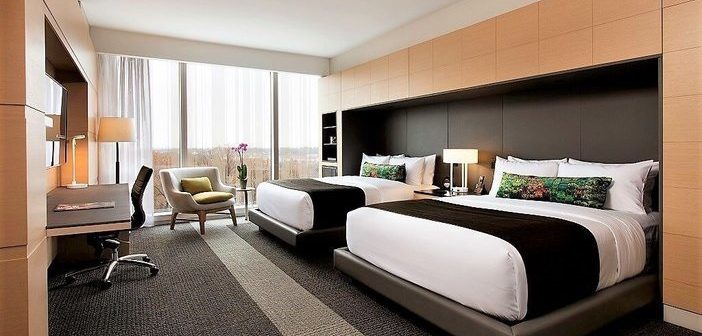by Ignacio Edenburg
According to analysts at Lodging Econometrics, the U.S. construction of new hotels is up in the first quarter of 2018 with 5,255 projects and a total of 636,174 rooms, up four percent by projects and six percent by rooms year over year. These numbers show healthy growth in the first quarter of 2018, but with so many projects under construction, what can hotel owners and developers do to stand out from the crowd and maintain a competitive edge?
Sustainability
We’re seeing major brands embrace and incorporate eco-friendly elements into the building design, case goods, policies, and practices. With developments in green manufacturing, more hotel properties are working towards qualifying for LEED certifications. However, hotels don’t necessarily need LEED certification to be considered environmentally friendly. Developers can install energy efficient lights, solar panels, or recycled wood and furniture that comes from a factory that operates with clean recycling and combustion of industrial remains. For example, factories used by Edenburg Hospitality use formaldehyde-free wood panels and glue, and works with natural veneers and lacquers.
This growing eco-friendly trend is highlighted by the Gold LEED MGM National Harbor situated on the Potomac River just south of Washington D.C., completed in 2016. Another example is the Hyatt Regency Seattle located in downtown Seattle. They include millwork in guestrooms in part, because of the green certifications issued by the European agencies that oversee the factory the woodwork or building product came from.
Millennials, a target customer base for hotels, are very eco-conscious. As a result, hotels are embracing sustainability and making it the new norm. Having sustainability on the top of their list when searching for hotels, Millennials often prioritize this over cost. By investing in ‘green’ hotel furniture, hotel owners are opening up their doors to guests who prioritize having an environmentally-friendly space over other amenities.
Lifestyle and neighborhood
Brands have always been hyper competitive, but with so much consolidation in the industry, hotel operators are going above and beyond, providing nice bed sheets, large flat screen TVs, and a good location. We’re seeing brands loosening up their design standards in favor of creating a unique experience for guests. For example, staying at a TRYP by Wyndham in New Jersey and a TRYP by Wyndham in Fort Lauderdale the guest can have two completely different experiences. Now, it is more about creating a lifestyle experience for guests and telling the story of the hotel in relation to a neighborhood, art, culture, and technology. For example, Edenburg Hospitality recently completed the interior design and manufactured the furniture and fixtures for the TRYP by Wyndham Maritime hotel located in Fort Lauderdale. To capitalize on the city’s top-notch marine industry, the TRYP by Wyndham Maritime on Marina Mile has a nautical and maritime theme throughout the hotel. The design includes exotic fish tanks and wave-like blue sofas adorning the hotel lobby, as well as underwater photographs by noted marine ecologist and photographer Richard Murphy in every guest room. Other design elements include circular light sconces resembling portholes on a ship, and the ceiling above the tapas bar simulates ripples of water. Another good example is Hotel Indigo in Pittsburgh, where the hotel design tells the story of the area’s historical steel industry past. Exposed ceilings and steel beams in the lobby remind guests of the property’s former life as the J&L Steel mill. The hotel was also designed to evoke memories of the neighborhood’s majestic theatre era.
Technology
With technology becoming more pervasive and finding itself inside the pockets of almost everyone, it’s no surprise to hear tech savvy individuals want to stay at a tech savvy hotel. Hotels that do not embrace new technologies will be left behind. Customers are now using their own devices to check-in at a hotel or download an app that allows guests to control just about everything from air conditioning in their room, to ordering room service. Guests also have the ability to use their own devices to unlock guestroom doors. Hotel brands are incorporating tech into every aspect of the design. Finding developers that can maintain a competitive edge is a great start to ensuring your hotel property is on top of the latest tech. By building smart hotels, such as the Henna Hotel in Japan that is manned only by robots, or replacing Wi-Fi with Li-Fi, which is an internet connection through the lights, the need for creativity is ever increasing when hiring or searching for a developer.
Communal spaces
There is a growing appetite for communal spaces among hotel guests. Hoteliers are turning the lobby into socializing spaces where guests can interact with one another, as well as creating events to bring guests together. The Aloft Hotel has become known for its communal bar area, and the Live at Aloft program features local artists performing in the hotel’s lounge. The Element Hotel’s new guestroom design features a communal room in the middle of four guestrooms, which allow guests to share a kitchen, dining area, and lounge. Hotel breakfast areas are another trend. It’s very rare to find a hotel without that offering these days.




